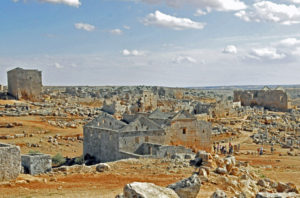
Remains of Serjilla, Syria (Photo by Don Knebel)
In the first century, people began building towns on the fertile western end of the Aleppo plateau in what is now northwestern Syria, taking advantage of the area’s location along the trading route between Anatolia and the East. Eventually, about 700 towns lay along a strip about 90 miles long, prospering by exchanging wheat, olive oil and wine for silver and gold. In the seventh century, the area came under the control of the Umayyad Caliphate, which changed the trade routes. The residents, their commercial opportunities eliminated, abandoned their towns and moved to the cities. Surprisingly, many of the buildings have survived more or less intact, creating an eerie impression of rural life at the height of the Byzantine Empire. In 2011, 40 abandoned villages were designated a UNESCO World Heritage Site named the “Ancient Villages of Northern Syria.”
Serjilla, located about 60 miles southwest of Aleppo, is among the best preserved of the so-called “Dead Cities.” Founded as a Christian town in 473 A.D., Serjilla includes the ruins of an ancient church. A few hundred feet from the church are a still-standing two story villa and the remains of a stone building containing an ancient olive press. Much better preserved are a large public bathhouse and a nearby meeting hall. Close by, in the abandoned town of al Bara, are two extraordinary pyramid-shaped tombs, the larger one encompassing five stone sarcophagi with Christian markings.
As Syrians have fled the fighting and bombings in Aleppo and other cities, thousands have sought refuge in the Dead Cities, some living in the tombs and others living in camps among the ruins. In Syria’s Dead Cities, life goes on.
Comments are closed.